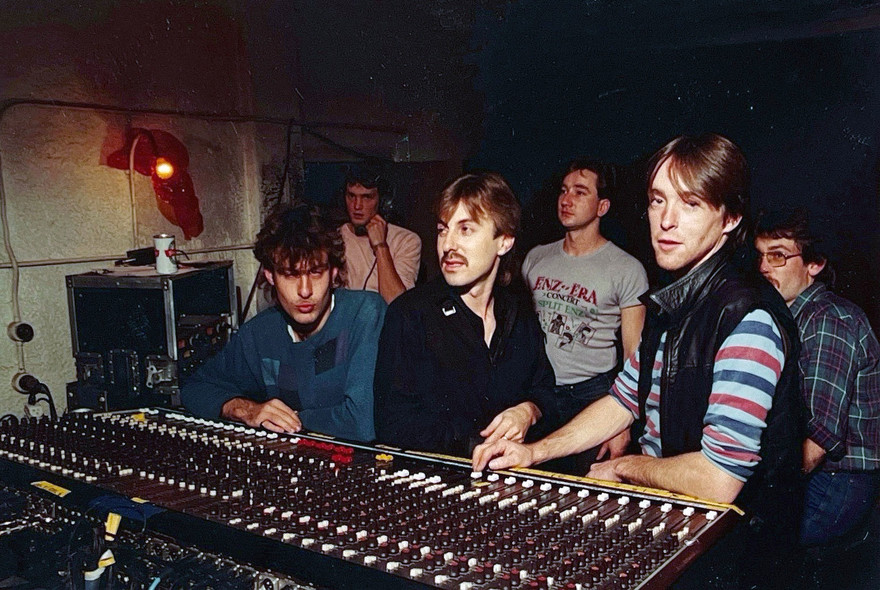
Beginning in 1983, Harlequin Studios was contracted to record Radio With Pictures’ Live at Mainstreet concerts so that they could be released on disc. Seen here at the cabaret, with a desk borrowed from Harlequin, are the studio’s engineers. Left to right: Martin Williams, Nick Morgan, Doug Rogers, Gerard Carr, Paul Streekstra and Steve Kennedy.
The ‘Repetition’ single by Dave Dobbyn’s DD Smash, released in December 1981, was the first fruit of a recent management change at Harlequin Studios. But in 1982, much bigger things were to come for Doug Rogers and Harlequin.
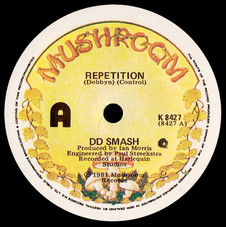
DD Smash - Repetition (Mushroom, 1981, before the Mushroom NZ label was available)
A couple of months earlier in 1981, with his workload increasing, Rogers hired former Split Enz and Citizen Band bassist Mike Chunn, then head of A&R at CBS in Parnell, as his new studio manager.
Chunn recalls being happy to “disembark from the CBS Records corporate world” and take the position.
“The studio was a technical goldmine”, he says, “but what really stood out was Doug’s strong determination to widen the station’s brief. Shortly after arriving, I was approached by Doug, who said, ‘You know Michael Gudinski at Mushroom Records, yes?’ ‘Yes’. ‘Why don’t you ring him and see if Harlequin could manage a Mushroom Records NZ label.’”
Chunn did exactly that, and within a week, Gudinski agreed; Chunn and Rogers then approached DD Smash’s manager Roger King, and late in 1981, Dave Dobbyn signed to Mushroom (all this news was announced in the December Rip It Up).
Engineers and more engineers
They were busy times and Rogers also had plans for a Production and Engineering School in the studio. Mike Chunn: “Not long after I started, Doug said, ‘We should host a record producers seminar series’. I thought, ‘Sheesh. Great idea.’
“Doug suggested I phone Roy Thomas Baker, the English producer who produced Queen albums to a huge level of success. ‘He’s recording the Cars in Boston,’ said Doug. I can’t recall how he got the name of the studio The Cars were in but he did and I rang it.
“‘Hi, I’m Mike Chunn from Harlequin Studios in New Zealand ... etc etc.’
“After a while, this English voice comes on the line. ‘Roy Thomas Baker here’ … ”
Doug Rogers recalls that he got the number from WEA Records boss Tim Murdoch.
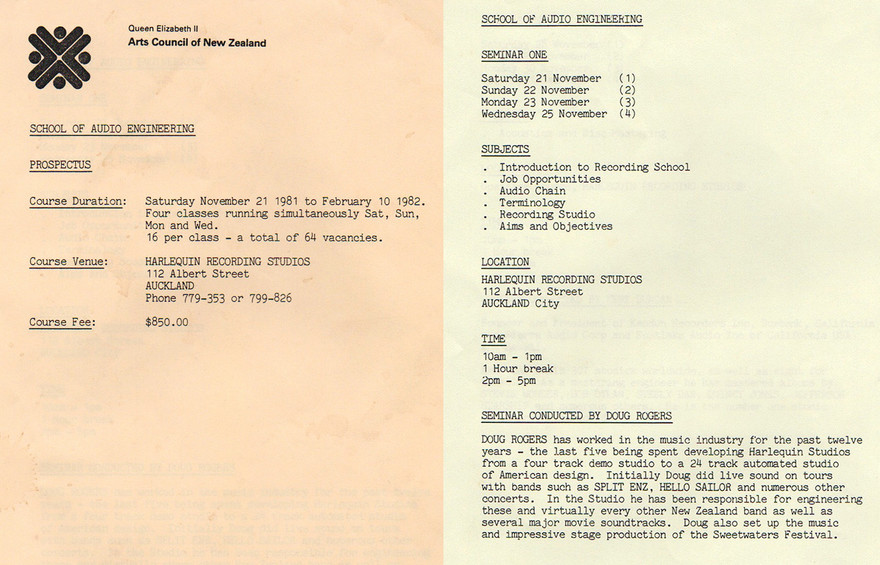
Harlequin School of Audio Engineering - Prospectus and Seminar One, conducted by Doug Rogers, Summer 1981/2
“I realised that we need some star power for the school to get people in,” says Rogers. “I wanted an acoustician, and I got Kent Duncan to come in and do that side, and I wanted a hot producer, so I called Tim because of his connections with the US WEA companies and asked him if he knew any producer up there that would come down and do the school. He came back with Roy, and said Roy will come down, even though he had just literally just finished producing The Cars and Devo.
“Really, he only came down for one reason – because he wanted to visit New Zealand. That was it. He wasn’t interested in coming down and doing a recording school but I was going to pay him to come down and visit New Zealand, and he had a grand old time. He stayed at Huka Lodge. He really enjoyed himself.”
Partially funded by the Queen Elizabeth II Arts Council, the classes started on 21 November 1981 and ran until 10 February 1982, broken down into 10 seminars. They were designed to teach new aspiring producers and engineers skills and to lift and polish the skills of already active ones, as Doug Rogers set his sights on making records that would find a mainstream market beyond New Zealand.
Debbie Harwood was studio assistant from 1981 to 1982, and then manager from 1984 to 1986. She remembers Doug as “the toughest man I’ve ever met, and determined – he flew by the seat of his pants”. Part of that determination was to start creating records that would comfortably sit on commercial radio offshore, particularly in the US. She recalls, “it was an attitude mostly loathed by the self-effacing Kiwis in the biz.”
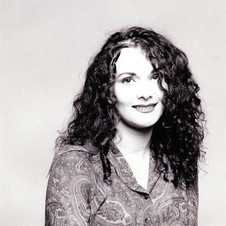
Debbie Harwood.
Harwood had arrived earlier in 1981. “I had driven up from Hawke’s Bay with a compulsion to pursue my music and singing. I decided to visit the studios in Auckland and just ask for work. I went to Last Laugh first – nothing there – and then wandered into Harlequin in Albert Street. Simon Alexander was the first person I encountered, and then Doug. There were no jobs but they were having the studio interior painted by this lone bloke up a ladder in exchange for studio time. Five hours of painting for one hour of studio time. They were keen to get it finished, so I took over for the same deal. I spent about two months up a very high ladder painting the walls grey.
“It was from the top of that ladder that I observed the recording of Graham [Brazier]’s Inside Out, the Blams’ Luxury Length and Graeme Gash’s album After the Carnival. I got to know both Patty and Doug, and when I’d finished painting, they offered me a job. No job title was attached, but I was essentially Doug’s PA and held the fort at the top of the stairs every day, fending off the characters of central Auckland and welcoming in the immense talent that existed at that time.”
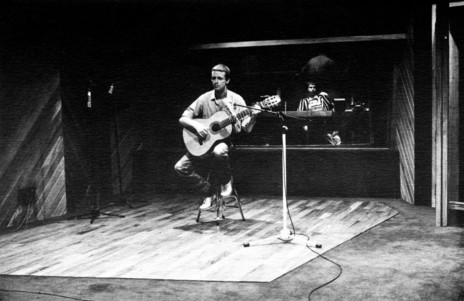
Lee Connolly recording at Harlequin.
Harwood witnessed the studio at work. “Patty was aesthetics maestro and also the iron fist in a velvet glove when personnel needed to be moved on. She was incredibly strong and took no prisoners when things needed to change, but she was also the warm face of Harlequin. Doug was the mastermind … big picture, not particularly comfortable with people, so the two of them were formidable together. Their strengths and weaknesses perfectly complemented each other. Doug had a tight hold on every tiny aspect of Harlequin/his vision.”
In his brief time in New Zealand (and, to be fair, limited interactions), Roy Thomas Baker was less positive. He told Rip It Up, “There seems to be animosity and a bit of a void between the technical people and the musical people … I’ve never seen anything like it.”
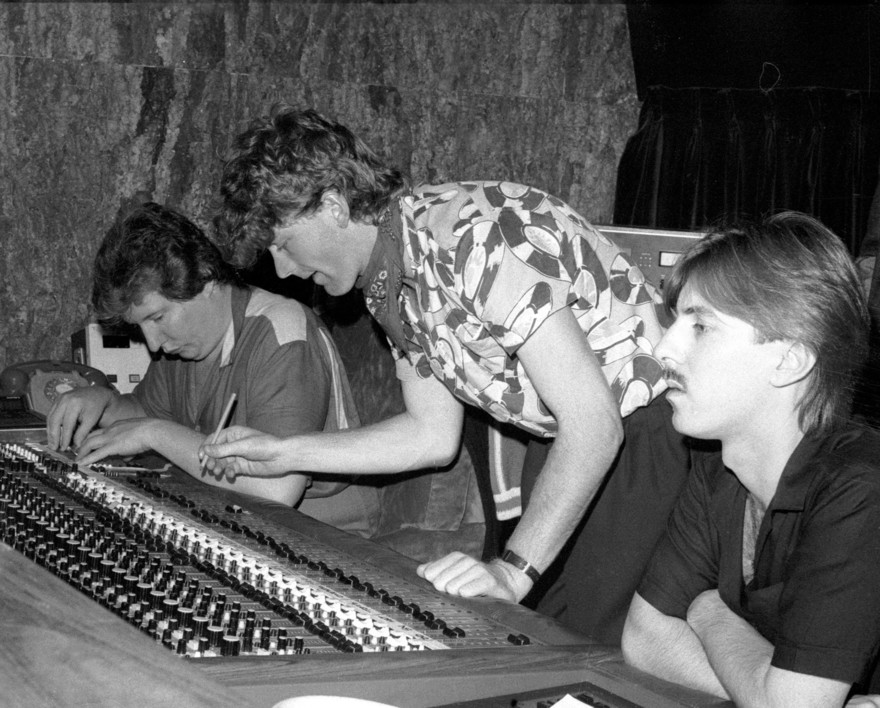
Roy Thomas Baker, engineer Ian Taylor and Doug Rogers at Harlequin Studios, early 1982. - Photo by Murray Cammick
Doug Rogers saw it the other way. “He just wasn’t a very good communicator. He approached it from the point of view of an everyday recording session. If someone is good, that doesn’t make them a good teacher.”
(This matches my memory too. Baker hardly spoke to the students, and there was ongoing vocal frustration from both the studio people and those who had paid the fee of $850 to attend. He looked so unwell ...)
“He drove those VU meters as far as they would go.”
Debbie Harwood: “Roy Thomas Baker turned up and [he] looked so ill … white as a ghost. My immediate thought was that he was on death’s door from years of excess. His hair was dyed pink and blue checkerboard style – with matching pale blue nylon pants and a pink shirt. Clearly, a savant but he had also clearly pushed it a bit hard through The Cars years. He began his session by mixing [DD Smash’s] ‘White Water’ – he drove those VU meters as far as they would go … way into distortion and compressed everything hard. The upshot was that the sound slammed right into our faces – a wild wall of sound. I loved it.”
Baker also recorded a track with Blam Blam Blam, ‘Time Enough’, which never saw the light in its Baker form, although the Blams stripped back the Baker production excesses – which horrified them – and reused the basic recording on their 1982 Luxury Length album. Parallel to the Baker sessions, Kent Duncan (then owner of Kendun Recorders and Sierra Audio in, Burbank, Los Angeles) held a disc mastering and acoustics session – completely rebuilding the Harlequin master control room in the process, working with the boffin that was (and is) Paul Jeffery.
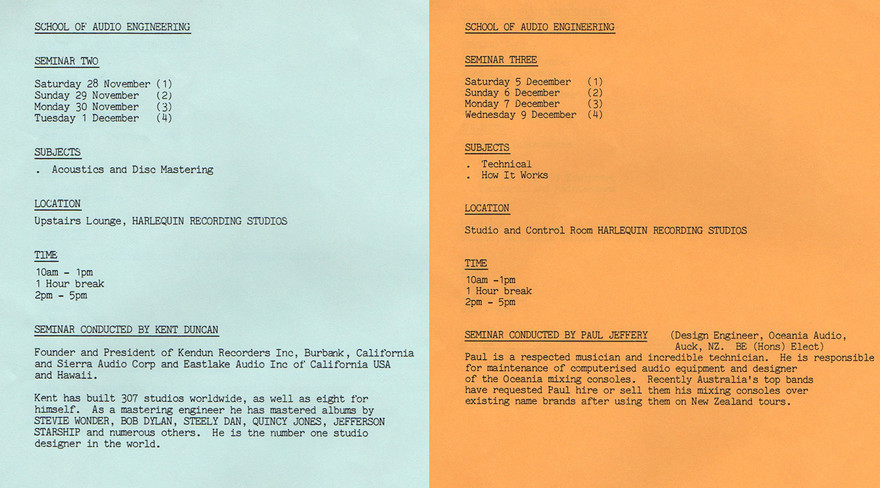
Harlequin School of Audio Engineering, Seminars Two and Three by Kent Duncan and Paul Jeffery.
“Paul was in Schtüng as well as a technician so he had an investment in the technology and in the art,” says Nick Morgan. “His input was crucial to the design of the studio and had enough technical understanding of analog circuitry to be able to make it all work. The studio had all kinds of problems and Paul was always brought in to wire it up and to make it all work. He was very important.”
During the school, Paul Jeffery held a technical class. “I had to do a whole-day seminar on the technical aspects of a recording studio, and a lot of the people who came to that were technicians from Radio New Zealand and things like that. It was quite embarrassing for me because I had to go and learn all this stuff. I didn’t know it much, and these were people who do that every day, you know, sandals and socks brigade … professionals.”
Nick Morgan was already working at Harlequin but also signed up to be one of the students at the school.
“I was still quite young, and didn’t have a lot of money, so I asked my mum and dad if they would front up $850. In those days, that was a chunk of money but they said yes. Thirty others also paid $850 to join the school. Roy Thomas Baker really didn’t want to be there. He was amused by this tiny control room full of kids and there wasn’t enough oxygen so we were all getting tired very quickly. [Roy’s] whole thing was to print the tracks as hard to tape as they possibly could. Nobody understood what that was about, he never explained, it was the loudest those monitors had ever been pushed. I don’t know if he was just trying to push people out of the space, but it worked. A lot of people went out of the room because it was just too loud. He never really said anything.
“After the school finished, I got to know Roy’s engineer [Ian Taylor] a little bit and learned a few things from him. The star pupil was supposed to get a job at Harlequin so they named me. I was already working there.”
Disappointed by the experience with Roy Thomas Baker, Harlequin's engineers tutored the next engineering course in June 1982.
Cool Bananas and more
In March, both Debbie Harwood and Mike Chunn moved on to full-time positions running the new Mushroom NZ label out of Mike's house in Brighton Road, Parnell and Festival Records’ offices in Carlton Gore Road, Grafton.
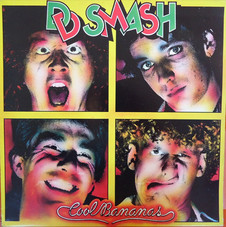
DD Smash - Cool Bananas (Mushroom NZ, 1982)
“Mike asked me to come with him and do the Mushroom thing,” remembers Harwood. “Doug and Patty wanted me to stay at Harlequin. I was being paid $240 per week at Harlequin, and Mike offered me a pie a day and a tank of petrol per week. I went with Mushroom because money didn’t mean a thing to me … music did.”
A couple of weeks after the move to Grafton, Mushroom NZ released DD Smash’s debut album Cool Bananas, produced by Ian Morris and engineered by Doug Rogers and Paul Streekstra at Harlequin. It entered the New Zealand albums charts at No.1 on 25 April, becoming the first local album ever to do so.
DD Smash’s album was followed in late May by Blam Blam Blam’s album Luxury Length (No.4, produced by the band and Paul Streekstra) and then in June by The Screaming Meemees’ If This Is Paradise, I’ll Take The Bag (No.8), also produced by Ian Morris with Steve Kennedy. All three albums lifted the game for New Zealand long-players substantially and sold significant quantities, underlining that the effort Doug Rogers had put into raising local studio skills, coupled with the availability of state-of-the-art gear, was paying off.
Mike Chunn, meanwhile, had flown to Christchurch and signed a hot young band at the suggestion of Christchurch promoter Jim Wilson. The Dance Exponents recorded their debut single ‘Victoria’ at Harlequin in June with Lee Connolly producing, releasing it on July 12 as they headed off on their first nationwide tour with The Screaming Meemees. It peaked at No.6 in August and launched the career of one of the most important New Zealand bands of the next two decades.
--